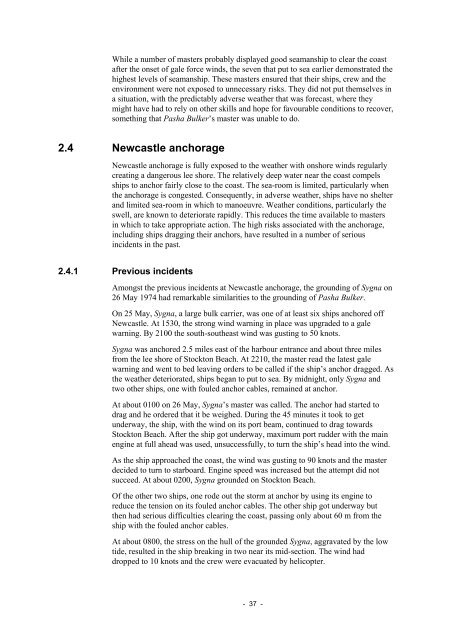Pasha Bulker 243 - Independent investigation into the grounding of ...
Pasha Bulker 243 - Independent investigation into the grounding of ...
Pasha Bulker 243 - Independent investigation into the grounding of ...
Create successful ePaper yourself
Turn your PDF publications into a flip-book with our unique Google optimized e-Paper software.
While a number <strong>of</strong> masters probably displayed good seamanship to clear <strong>the</strong> coast<br />
after <strong>the</strong> onset <strong>of</strong> gale force winds, <strong>the</strong> seven that put to sea earlier demonstrated <strong>the</strong><br />
highest levels <strong>of</strong> seamanship. These masters ensured that <strong>the</strong>ir ships, crew and <strong>the</strong><br />
environment were not exposed to unnecessary risks. They did not put <strong>the</strong>mselves in<br />
a situation, with <strong>the</strong> predictably adverse wea<strong>the</strong>r that was forecast, where <strong>the</strong>y<br />
might have had to rely on o<strong>the</strong>r skills and hope for favourable conditions to recover,<br />
something that <strong>Pasha</strong> <strong>Bulker</strong>’s master was unable to do.<br />
2.4 Newcastle anchorage<br />
Newcastle anchorage is fully exposed to <strong>the</strong> wea<strong>the</strong>r with onshore winds regularly<br />
creating a dangerous lee shore. The relatively deep water near <strong>the</strong> coast compels<br />
ships to anchor fairly close to <strong>the</strong> coast. The sea-room is limited, particularly when<br />
<strong>the</strong> anchorage is congested. Consequently, in adverse wea<strong>the</strong>r, ships have no shelter<br />
and limited sea-room in which to manoeuvre. Wea<strong>the</strong>r conditions, particularly <strong>the</strong><br />
swell, are known to deteriorate rapidly. This reduces <strong>the</strong> time available to masters<br />
in which to take appropriate action. The high risks associated with <strong>the</strong> anchorage,<br />
including ships dragging <strong>the</strong>ir anchors, have resulted in a number <strong>of</strong> serious<br />
incidents in <strong>the</strong> past.<br />
2.4.1 Previous incidents<br />
Amongst <strong>the</strong> previous incidents at Newcastle anchorage, <strong>the</strong> <strong>grounding</strong> <strong>of</strong> Sygna on<br />
26 May 1974 had remarkable similarities to <strong>the</strong> <strong>grounding</strong> <strong>of</strong> <strong>Pasha</strong> <strong>Bulker</strong>.<br />
On 25 May, Sygna, a large bulk carrier, was one <strong>of</strong> at least six ships anchored <strong>of</strong>f<br />
Newcastle. At 1530, <strong>the</strong> strong wind warning in place was upgraded to a gale<br />
warning. By 2100 <strong>the</strong> south-sou<strong>the</strong>ast wind was gusting to 50 knots.<br />
Sygna was anchored 2.5 miles east <strong>of</strong> <strong>the</strong> harbour entrance and about three miles<br />
from <strong>the</strong> lee shore <strong>of</strong> Stockton Beach. At 2210, <strong>the</strong> master read <strong>the</strong> latest gale<br />
warning and went to bed leaving orders to be called if <strong>the</strong> ship’s anchor dragged. As<br />
<strong>the</strong> wea<strong>the</strong>r deteriorated, ships began to put to sea. By midnight, only Sygna and<br />
two o<strong>the</strong>r ships, one with fouled anchor cables, remained at anchor.<br />
At about 0100 on 26 May, Sygna’s master was called. The anchor had started to<br />
drag and he ordered that it be weighed. During <strong>the</strong> 45 minutes it took to get<br />
underway, <strong>the</strong> ship, with <strong>the</strong> wind on its port beam, continued to drag towards<br />
Stockton Beach. After <strong>the</strong> ship got underway, maximum port rudder with <strong>the</strong> main<br />
engine at full ahead was used, unsuccessfully, to turn <strong>the</strong> ship’s head <strong>into</strong> <strong>the</strong> wind.<br />
As <strong>the</strong> ship approached <strong>the</strong> coast, <strong>the</strong> wind was gusting to 90 knots and <strong>the</strong> master<br />
decided to turn to starboard. Engine speed was increased but <strong>the</strong> attempt did not<br />
succeed. At about 0200, Sygna grounded on Stockton Beach.<br />
Of <strong>the</strong> o<strong>the</strong>r two ships, one rode out <strong>the</strong> storm at anchor by using its engine to<br />
reduce <strong>the</strong> tension on its fouled anchor cables. The o<strong>the</strong>r ship got underway but<br />
<strong>the</strong>n had serious difficulties clearing <strong>the</strong> coast, passing only about 60 m from <strong>the</strong><br />
ship with <strong>the</strong> fouled anchor cables.<br />
At about 0800, <strong>the</strong> stress on <strong>the</strong> hull <strong>of</strong> <strong>the</strong> grounded Sygna, aggravated by <strong>the</strong> low<br />
tide, resulted in <strong>the</strong> ship breaking in two near its mid-section. The wind had<br />
dropped to 10 knots and <strong>the</strong> crew were evacuated by helicopter.<br />
- 37 -
















